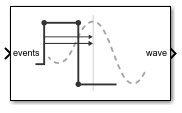Slew Rate
Model amplitude, rise and fall times, and propagation delay of logic gates
Libraries:
Mixed-Signal Blockset /
Utilities
Description
The Slew Rate block converts a logical signal to a signal with user-defined finite slew rate and propagation delay.
Ports
Input
Variable step, event driven input signal, specified as a scalar. The signal at events port comes from the output of a logic gate such as Variable Pulse Delay block.
Data Types: single | double | int8 | int16 | int32 | int64 | uint8 | uint16 | uint32 | uint64 | Boolean
Output
Fixed step, uniformly sampled output signal, returned as a scalar. You can define the finite slew rate and propagation delay for the signal at the wave port.
Data Types: double
Parameters
Defines how to calculate output step size.
Choose
Defaultto calculate Output step size calculation based on rise/fall time. The Output sample interval (ΔT) is given by .Choose
Advancedto calculate Output step size calculation based on frequency of interest. The Output sample interval (ΔT) is given by .
Programmatic Use
Use
get_param(gcb,'DefaultOrAdvanced')to determine how the output step size is being calculated.
Maximum frequency of interest at output, specified as a scalar in Hz. Maximum frequency of interest is used to calculate Output sample interval and Minimum 20%-80% rise/fall time.
Dependencies
This parameter is only available when Advanced is selected for
Output step size calculation.
Programmatic Use
Use
get_param(gcb,'MaxFreqInterest')to view the current value of Maximum frequency of interest.Use
set_param(gcb,'MaxFreqInterest',value)to set Maximum frequency of interest to a specific value.
Output sample interval, specified as a scalar in s. This parameter is nontunable.
The Output sample interval (ΔT) is given by .
Dependencies
This parameter is only available when Advanced is selected for
Output step size calculation.
Programmatic Use
Use
get_param(gcb,'OutputSampleTime')to view the current value of Output sample interval.Use
set_param(gcb,'OutputSampleTime',value)to set Output sample interval to a specific value.
Minimum rise/fall time required at the output for meaningful simulation, specified as a scalar in ps. This is a nontunable parameter.
Dependencies
This parameter is only available when Advanced is selected for
Output step size calculation.
Programmatic Use
Use
get_param(gcb,'ConversionRiseFall')to view the current value of Minimum 20%-80% rise/fall time.Use
set_param(gcb,'ConversionRiseFall',value)to set Minimum 20%-80% rise/fall time to a specific value.
Time required for signal to change from 20% to 80% in a full amplitude edge at the output, specified as a scalar.
Programmatic Use
Use
get_param(gcb,'RiseTime')to view the current value of Rise/fall time.Use
set_param(gcb,'RiseTime',value)to set Rise/fall time to a specific value.
Slew rate for the 20%-80% edge at the output, specified as a scalar. This parameter is nontunable.
Programmatic Use
Use
get_param(gcb,'RisingSlewRate')to view the current value of Slew rate for 20%-80% edge of unit amplitude signal.Use
set_param(gcb,'RisingSlewRate',value)to set Slew rate for 20%-80% edge of unit amplitude signal to a specific value.
Minimum propagation delay for meaningful simulation, specified as a scalar. This parameter is nontunable.
Minimum propagation delay is calculated from Maximum frequency of interest where .
Programmatic Use
Use
get_param(gcb,'ConversionDelay')to view the current value of Minimum propagation delay.Use
set_param(gcb,'ConversionDelay',value)to set Minimum propagation delay to a specific value.
Propagation delay of a rising edge, specified as a scalar in s. Propagation delay is measured at a threshold equal to the half of the amplitude.
Programmatic Use
Use
get_param(gcb,'RisepropDelay')to view the current value of Propagation delay.Use
set_param(gcb,'RisePropDelay',value)to set Propagation delay to a specific value.
Select to enable increased buffer size during the simulation. This increases the buffer size of all the blocks in the PLL model that belong to the Mixed-Signal Blockset™/Utilities Simulink® library. By default, this option is deselected.
Buffer size of all the blocks in the PLL model that belong to the Mixed-Signal Blockset/Utilities Simulink library.
Selecting different simulation solver or sampling strategies can change the number of input samples needed to produce an accurate output sample. Set the Buffer size to a large enough value so that the input buffer contains all the input samples required.
Dependencies
This parameter is only available when the Enable increased buffer size option is selected.
Programmatic Use
Use
get_param(gcb,'NBuffer')to view the current value of Buffer size.Use
set_param(gcb,'NBuffer',value)to set Buffer size to a specific value.
Version History
Introduced in R2019a
See Also
MATLAB Command
You clicked a link that corresponds to this MATLAB command:
Run the command by entering it in the MATLAB Command Window. Web browsers do not support MATLAB commands.
Select a Web Site
Choose a web site to get translated content where available and see local events and offers. Based on your location, we recommend that you select: .
You can also select a web site from the following list
How to Get Best Site Performance
Select the China site (in Chinese or English) for best site performance. Other MathWorks country sites are not optimized for visits from your location.
Americas
- América Latina (Español)
- Canada (English)
- United States (English)
Europe
- Belgium (English)
- Denmark (English)
- Deutschland (Deutsch)
- España (Español)
- Finland (English)
- France (Français)
- Ireland (English)
- Italia (Italiano)
- Luxembourg (English)
- Netherlands (English)
- Norway (English)
- Österreich (Deutsch)
- Portugal (English)
- Sweden (English)
- Switzerland
- United Kingdom (English)
